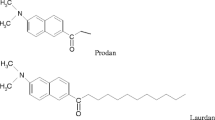Abstract
Complementary investigation of Laurdan fluorescence emission and second harmonic (SH) spectra in nonpolar, protic and aprotic polar solvents and phospholipid bilayers was carried out. SH of spectra computed using methods familiar in electro spin resonance spectroscopy yielded better resolution. Spectra were fit to log-normal distributions. SH spectra showed presence of two emissions in protic polar and nonpolar solvents and in both bilayer gel and liquid phases and a single line in aprotic polar solvents. Each of the half maximal positions of each line in both homogenous solvents and bilayers, expresses similar linearity with peak position. This shared feature suggests planar and nonplanar Laurdan conformation respectively in the longer (red) and shorter (blue) wavelength emitting states. The weaker 432 nm blue line, not detected before in the gel phase, is distinguishable in the SH. Temperature trajectories of areas and peak positions of the individual lines bring new insight into the nature of lipid packing and evolution of domains, indicating inhomogeneous lipid packing even in the gel phase. The blue line identifies as emission from Laurdan in tighter packed regions and the dominant 445–448 nm red line in the gel phase shifting to 484 nm in the liquid phase as emission from Laurdan-water coupled states that are in varying stages of relaxation according to temperature and phase. Unexpected increase in the area of the blue line with temperature through the gel-liquid transition is consistent with coexisting low and high curvature domains and Laurdan’s preference for less polar low curvature domains.






Similar content being viewed by others
References
Burstein EA, Emelyanenko VI (1996) Log-Normal description of fluorescence spectra of organic Fluorophores. Photochem Photobiol 64(2):316–320. https://doi.org/10.1111/j.1751-1097.1996.tb02464.x
Bacalum M, Zorila B, Radu M (2013) Fluorescence spectra decomposition by asymmetric functions: Laurdan spectrum revisited. Anal Biochem 440:123–129
Parasassi T, Krasnowska EK, Bagatolli L, Gratton E (1998) Laurdan and Prodan as polarity-sensitive fluorescent membrane probes. J Fluoresc 8(4):365–373. https://doi.org/10.1023/A:1020528716621
Bacalum M, Zorila B, Radu M, Popescu A (2013) Laurdan solvatochromism: influence of solvent polarity and hydrogen bonds. Optoelectron Adv Mater 7:456–460
Bluzas GL (1995) Study of modulation effects on ESR spectra. M.S. Thesis, California State University Northridge
Mooney J, Kambhampati P (2013) Get the basics right: Jacobian conversion of wavelength and energy scales for quantitative analysis of emission spectra. J Phys Chem Lett 4(19):3316–3318. https://doi.org/10.1021/jz401508t
Poole CPJ (1983) Electron spin resonance: a comprehensive treatise on experimental technique, 2nd edn. Wiley, New York
Siano DB, Metzler DE (1969) Band shapes of the electronic spectra of complex molecules. J Chem Phys 51(5):1856–1861. https://doi.org/10.1063/1.1672270
Ku HH (1966) Notes on the use of propagation of error formulas. J Res Natl Bureau Standards-C Eng Instrument 70C(4):263–273
Bagatolli LA, Parasassi T, Fidello GD, Gratton E (1999) A Model for the Interaction of 6-Lauroyl-2-(N,N-dimethylamino)naphthalene with Lipid Environments: Implications for Spectral Properties. Photochem Photobiol 70(4):557–564
Viard M, Gallay J, Vincent M, Meyer O, Robert B, Paternostre M (1997) Laurdan solvatochromism: solvent dielectric relaxation and intramolecular excited-state reaction. Biophys J 73(4):2221–2234. https://doi.org/10.1016/s0006-3495(97)78253-5
Bagatolli LA (2006) To see or not to see: lateral organization of biological membranes and fluorescence microscopy. Biochim Biophys Acta Biomembr 1758(10):1541–1556. https://doi.org/10.1016/j.bbamem.2006.05.019
Harris FM, Best KB, Bell JD (2002) Use of laurdan fluorescence intensity and polarization to distinguish between changes in membrane fluidity and phospholipid order. Biochim Biophys Acta Biomembr 1565(1):123–128. https://doi.org/10.1016/S0005-2736(02)00514-X
Parasassi T, Stasio G, Ravagnan G, Rusch RM, Gratton E (1991) Quantitation of lipid phases in phospholipid vesicles by the generalized polarization of Laurdan fluorescence. Biophys J 60:179–189
Vincent M, de Foresta B, Gallay J (2005) Nanosecond dynamics of a mimicked membrane-water Interface observed by time-resolved stokes shift of LAURDAN. Biophys J 88(6):4337–4350. https://doi.org/10.1529/biophysj.104.057497
Parasassi T, De Stasio G, d'Ubaldo A, Gratton E (1990) Phase fluctuation in phospholipid membranes revealed by Laurdan fluorescence. Biophys J 57(6):1179–1186. https://doi.org/10.1016/S0006-3495(90)82637-0
Merlo S, Yager P (1990) Optical method for monitoring the concentration of general anesthetics and other small organic molecules. An example of phase transition sensing. Anal Chem 62(24):2728–2735. https://doi.org/10.1021/ac00223a015
Viard M, Gallay J, Vincent M, Paternostre M (2001) Origin of laurdan sensitivity to the vesicle-to-micelle transition of phospholipid-octylglucoside system: a time-resolved fluorescence study. Biophys J 80(1):347–359. https://doi.org/10.1016/s0006-3495(01)76019-5
Parasassi T, Gratton E (1992) Packing of phospholipid vesicles studied by oxygen quenching of Laurdan fluorescence. J Fluoresc 2(3):167–174. https://doi.org/10.1007/bf00866931
Parasassi T, Ravagnan G, Rusch RM, Gratton E (1993) Modulation and dynamics of phase properties in phospholipid mixtures detected by laurdan fluorescence*. Photochem Photobiol 57(3):403–410. https://doi.org/10.1111/j.1751-1097.1993.tb02309.x
Bagatolli LA, Gratton E (2001) Direct observation of lipid domains in free-standing bilayers using two-photon excitation fluorescence microscopy. J Fluoresc 11(3):141–160. https://doi.org/10.1023/a:1012228631693
Parasassi T, Gratton E, Yu WM, Wilson P, Levi M (1997) Two-photon fluorescence microscopy of laurdan generalized polarization domains in model and natural membranes. Biophys J 72(6):2413–2429. https://doi.org/10.1016/S0006-3495(97)78887-8
Fourkas JT, Berg M (1993) Temperature-dependent ultrafast solvation dynamics in a completely nonpolar system. J Chem Phys 98(10):7773–7785. https://doi.org/10.1063/1.464585
Morozova Y, Zharkova O, Balakina T, Artyukhov V, Korolev B (2011) Conformal transitions of the laurdan molecule in the absorption and fluorescence spectra. Russ Phys J 54:594–600. https://doi.org/10.1007/s11182-011-9657-5
Chen B, Siepmann JI (2006) Microscopic structure and solvation in dry and wet Octanol. J Phys Chem B 110(8):3555–3563. https://doi.org/10.1021/jp0548164
Acknowledgements
The authors gratefully acknowledge NIH for their support through grant contract # 1SC3GM122499-01A1 and NSF MRI Grant 1626632. MP acknowledges NSF for RUI 1856746.
Author information
Authors and Affiliations
Corresponding author
Additional information
Publisher’s Note
Springer Nature remains neutral with regard to jurisdictional claims in published maps and institutional affiliations.
Electronic supplementary material
ESM 1
(PDF 2793 kb)
Rights and permissions
About this article
Cite this article
Ranganathan, R., Burkin, A.J. & Peric, M. Complementary Fluorescence Emission and Second Harmonic Spectra Improve Bilayer Characterization. J Fluoresc 30, 205–212 (2020). https://doi.org/10.1007/s10895-020-02487-1
Received:
Accepted:
Published:
Issue Date:
DOI: https://doi.org/10.1007/s10895-020-02487-1




